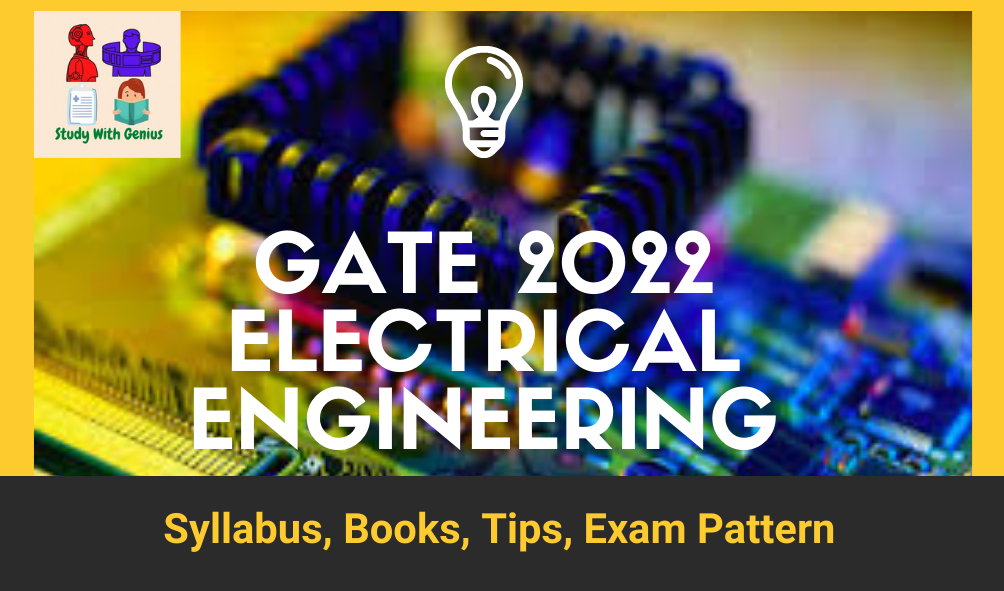GATE 2022 Syllabus Electrical engineering is concerned with the study of electronic devices and equipment, as well as the application of principles to electricity. They also test and supervise the production of electrical equipment. Electrical engineering is a discipline of science that deals with power electronics and develops reliable and efficient electronic systems. Physics, mechanics, optics, and related mathematics are all covered.
Electrical engineers are in high demand as technology advances at a rapid pace. GATE 2022 Syllabus Electrical engineering and Electronics engineering are commonly studied together in the same stream because they cover related ideas. (
GATE 2022 EE book )
To become an electrical engineer, one must enrol in an engineering college and complete a technical degree. The bachelor’s programme in electrical engineering lasts four years, while the master’s programme lasts two years.
Electrical engineering is taught in many institutes, and students learn about electrical devices, semiconductors, and microprocessors. It takes a team of electrical engineers to turn on and off the lights in your room or check the clock on your smartphone. Electricity is one of the most commonly used forms of energy in our daily lives.( GATE 2022 Syllabus )
GATE 2022 Syllabus Electrical Engineering
Section1: Engineering Mathematics
Linear Algebra:
Matrix Algebra, Systems of linear equations, Eigenvalues, Eigenvectors.
Calculus:
Mean value theorems, Theorems of integral calculus, Evaluation of definite and improper integrals, Partial Derivatives, Maxima and minima, Multiple integrals, Fourier series, Vector identities, Directional derivatives, Line integral, Surface integral, Volume integral, Stokes’s theorem, Gauss’s theorem, Divergence theorem, Green’s theorem.
Differential equations:
First order equations (linear and nonlinear), Higher order linear differential equations with
constant coefficients, Method of variation of parameters, Cauchy’s equation, Euler’s equation, Initial and boundary value problems, Partial Differential Equations, Method of separation of variables.
Complex variables:
Analytic functions, Cauchy’s integral theorem, Cauchy’s integral formula, Taylor series, Laurent series, Residue theorem, Solution integrals.
Probability and Statistics:
Sampling theorems, Conditional probability, Mean, Median, Mode, Standard Deviation, Random variables, Discrete and Continuous distributions, Poisson distribution, Normal distribution, Binomial distribution, Correlation analysis, Regression analysis.
Section 2: Electric circuits
Network elements: ideal voltage and current sources, dependent sources, R, L, C, M elements; Network solution methods: KCL, KVL, Node and Mesh analysis; Network Theorems: Thevenin’s, Norton’s, Superposition and Maximum Power Transfer theorem; Transient response of dc and ac networks, sinusoidal steady-state analysis, resonance, two port networks, balanced three phase circuits, star-delta transformation, complex power and power factor in ac circuits.
Section 3: Electromagnetic Fields
Coulomb’s Law, Electric Field Intensity, Electric Flux Density, Gauss’s Law, Divergence, Electric field and potential due to point, line, plane and spherical charge distributions, Effect of dielectric medium, Capacitance of simple configurations, Biot‐Savart’s law, Ampere’s law, Curl, Faraday’s law, Lorentz force, Inductance, Magnetomotive force, Reluctance, Magnetic circuits, Self and Mutual inductance of simple configurations.
Section 4: Signals and System
Representation of continuous and discrete time signals, shifting and scaling properties, linear time invariant and causal systems, Fourier series representation of continuous and discrete time periodic signals, sampling theorem, Applications of Fourier Transform for continuous and discrete time signals, Laplace Transform and Z transform.
Section 5: Electrical Machines
Single phase transformer: equivalent circuit, phasor diagram, open circuit and short circuit tests, regulation and efficiency; Three-phase transformers: connections, vector groups, parallel operation; Auto-transformer, Electromechanical energy conversion principles; DC machines: separately excited, series and shunt, motoring and generating mode of operation and their characteristics, speed control of dc motors; Three-phase induction machines: principle of operation, types, performance, torque-speed characteristics, no-load and blocked-rotor
tests, equivalent circuit, starting and speed control; Operating principle of single-phase induction motors; Synchronous machines: cylindrical and salient pole machines, performance and characteristics, regulation and parallel operation of generators, starting of synchronous motors; Types of losses and efficiency calculations of electric machines.
Section 6: Power Systems
Basic concepts of electrical power generation, ac and dc transmission concepts, Models and performance of transmission lines and cables, Series and shunt compensation, Electric field distribution and insulators, Distribution systems, Per‐unit quantities, Bus admittance matrix, Gauss- Seidel and Newton-Raphson load flow methods, Voltage and Frequency control, Power factor correction, Symmetrical components, Symmetrical and unsymmetrical fault analysis, Principles of over‐current, differential, directional and distance protection; Circuit breakers, System stability concepts, Equal area criterion, Economic Load Dispatch (with and without considering transmission losses).
Section 7: Control Systems
Mathematical modeling and representation of systems, Feedback principle, transfer function, Block diagrams and Signal flow graphs, Transient and Steady‐state analysis of linear time invariant systems, Stability analysis using Routh-Hurwitz and Nyquist criteria, Bode plots, Root loci, Lag, Lead and Lead‐Lag compensators; P, PI and PID controllers; State space model, Solution of state equations of LTI systems, R.M.S. value, average value calculation for any general periodic waveform.
Section 8: Electrical and Electronic Measurements
Bridges and Potentiometers, Measurement of voltage, current, power, energy and power factor; Instrument transformers, Digital voltmeters and multimeters, Phase, Time and Frequency measurement; Oscilloscopes, Error analysis.
Section 9: Analog and Digital Electronics
Simple diode circuits: clipping, clamping, rectifiers; Amplifiers: biasing, equivalent circuit and frequency response; oscillators and feedback amplifiers; operational amplifiers: characteristics and applications; single stage active filters, Sallen Key, Butterworth, VCOs and timers, combinatorial and sequential logic circuits, multiplexers, demultiplexes, Schmitt triggers, sample and hold circuits, A/D and D/A converters.
Section 10: Power Electronics
Static V-I characteristics and firing/gating circuits for Thyristor, MOSFET, IGBT; DC to DC conversion: Buck, Boost and Buck-Boost Converters; Single and three-phase configuration of uncontrolled rectifiers; Voltage and Current commutated Thyristor based converters; Bidirectional ac to dc voltage source converters; Magnitude and Phase of line current harmonics for uncontrolled and thyristor based converters; Power factor and Distortion Factor of ac to dc converters; Single-phase and three-phase voltage and current source inverters, sinusoidal pulse
width modulation.
GATE Electrical Engineering: Weightage
| Topic | Number of Question | Marks |
|---|---|---|
| Network Theory | 6 | 9 |
| Control Systems | 7 | 11 |
| Signal And Systems | 3 | 5 |
| Digital Electronics | 4 | 7 |
| Analog Circuits | 4 | 5 |
| EMT | 3 | 4 |
| Electrical Machines | 3 | 4 |
| Measurements | 7 | 11 |
| Power Systems | 6 | 10 |
| Power Electronics | 5 | 9 |
| Engineering Mathematics | 7 | 10 |
| General Aptitude | 10 | 15 |
| Total | 65 | 100 |
GATE 2022 EE Exam Pattern
- Mode of Examination: Online
- Duration of Exam: 3 hours
- Types of Questions: MCQs and NAT
- Sections: 3 sections – General Aptitude, Mathematics and Subject-based
- Total Questions: 65 questions
- Total Marks: 100 marks
- Negative Marking: For MCQs only
There are three paper sections, each carrying a different weightage of marks. The below table describes the distribution of marks in each section:
| Paper Section | Marks distribution |
|---|---|
| Subject Questions | 72% |
| Engineering Mathematics | 13% |
| General Aptitude | 15% |
| Type of question | Negative marking for wrong answer |
|---|---|
| MCQs | 1/3 for 1 mark questions 2/3 for 2 marks questions |
| NATs | No negative marking |
GATE 2022 EE book : Section Wise Books
Topics | Books |
Engineering Mathematics | Advanced Engineering Mathematics by E.Kreyszig |
Networks | Engineering Circuit Analysis by Hayt & Kemmerly |
Signal and systems | Signals and Systems by Oppenheim & Wilsky Signals and Systems by Nagoor Kani |
Electrical Machine | Electrical Machinery by P.S.Bimbhra |
Control system | Control Systems Engineering by Nagrath & Gopal |
Measurement | Electrical and Electronic Measurement & Instrumentation by AK Sawhney |
Circuit analysis | Transient Analysis Of Electric Power Circuits by Arieh L Shenkmann and also Chakrabarthi |
Analog | Electronic Devices and Circuit Theory by Boylestad |
Digital Circuits | Digital Design by M.Morris Mano |
Electro Magnetics | Elements of Electromagnetics by Mathew N. O. Sadiku Engineering Electromagnetics by William .H.Hayt |
Power Electronics | For Beginners - Power Electronics by MH Rashid Power Electronics by P.S.Bimbhra |
Power system | Power Systems Engineering by Nagrath & Kothari Power Systems by JB Gupta & CL Wadhwa |
GATE 2022 Prepatarion Tips
1. Solving Practice Papers
- Solve practise papers on a daily basis to obtain a better understanding of the exam pattern, question types, difficulty level, and so on.
- Examine your weak spots.
- If you are unable to answer the questions, do not become concerned.
2. Try to Complete whole Syllabus
- Do not save any topics at the last minute. Try to finish your syllabus at least two weeks before the exam.
- You must begin your improvements when you have completed your curriculum.
- Make sure you go over your syllabus several times to ensure you don’t forget anything.
3. Regular Practice
- Daily question practise will assist you in slowing down your ageing process.
- Candidates must also keep in mind that while their speed improves, their accuracy must improve as well.
- Make an effort to complete more and more mock tests.
| Time Allotment | Activities to Do |
|---|---|
| 5:00 AM to 8:00 AM | Revision of Topics |
| 8:00 AM to 10:00 AM | Take a Break |
| 10:00 AM to 1:00 PM | Pick up a Major Topic |
| 1:00 PM to 5:00 PM | Take a Break |
| 6:00 PM to 9:00 PM | Pick up next/incomplete topic |
| 10:00 PM | Revise again |







